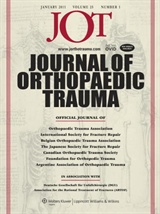 | |
| Discipline | Orthopedics and sports medicine |
|---|---|
| Language | English |
| Edited by | William M. Ricci, MD |
| Publication details | |
| History | 1987-present |
| Publisher | Lippincott Williams & Wilkins (United States) |
| Frequency | Monthly |
| 2.3 (2022) | |
| Standard abbreviations | |
| ISO 4 | J. Orthop. Trauma |
| Indexing | |
| ISSN | 0890-5339 (print) 1531-2291 (web) |
| OCLC no. | 14257379 |
| Links | |
The Journal of Orthopaedic Trauma is a monthly, peer-reviewed, orthopaedic journal published by Lippincott Williams & Wilkins. It was established in 1987. The editor in chief is William M. Ricci, MD. [1] [2]
Contents
This journal is the official publication of the Orthopaedic Trauma Association, International Society for Fracture Repair, Belgian Orthopaedic Trauma Association, Japan Fracture Society, and the Canadian Orthopaedic Trauma Society. [3]